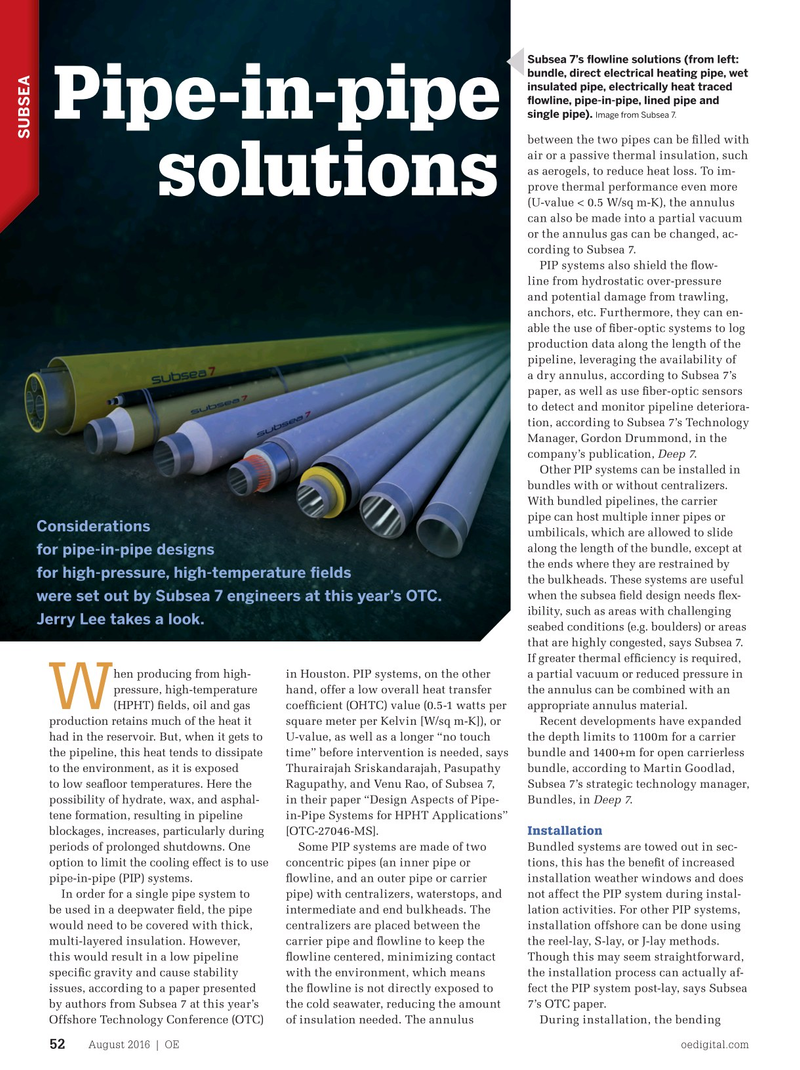
Page 50: of Offshore Engineer Magazine (Aug/Sep 2016)
Read this page in Pdf, Flash or Html5 edition of Aug/Sep 2016 Offshore Engineer Magazine
Subsea 7’s ? owline solutions (from left: bundle, direct electrical heating pipe, wet insulated pipe, electrically heat traced ? owline, pipe-in-pipe, lined pipe and single pipe). Image from Subsea 7.
Pipe-in-pipe
SUBSEA between the two pipes can be ? lled with air or a passive thermal insulation, such as aerogels, to reduce heat loss. To im- prove thermal performance even more solutions (U-value < 0.5 W/sq m-K), the annulus can also be made into a partial vacuum or the annulus gas can be changed, ac- cording to Subsea 7.
PIP systems also shield the ? ow- line from hydrostatic over-pressure and potential damage from trawling, anchors, etc. Furthermore, they can en- able the use of ? ber-optic systems to log production data along the length of the pipeline, leveraging the availability of a dry annulus, according to Subsea 7’s paper, as well as use ? ber-optic sensors to detect and monitor pipeline deteriora- tion, according to Subsea 7’s Technology
Manager, Gordon Drummond, in the company’s publication, Deep 7.
Other PIP systems can be installed in bundles with or without centralizers.
With bundled pipelines, the carrier pipe can host multiple inner pipes or
Considerations umbilicals, which are allowed to slide along the length of the bundle, except at for pipe-in-pipe designs the ends where they are restrained by for high-pressure, high-temperature ? elds the bulkheads. These systems are useful when the subsea ? eld design needs ? ex- were set out by Subsea 7 engineers at this year’s OTC. ibility, such as areas with challenging
Jerry Lee takes a look.
seabed conditions (e.g. boulders) or areas that are highly congested, says Subsea 7.
If greater thermal ef? ciency is required, in Houston. PIP systems, on the other hen producing from high- a partial vacuum or reduced pressure in hand, offer a low overall heat transfer pressure, high-temperature the annulus can be combined with an
W coef? cient (OHTC) value (0.5-1 watts per (HPHT) ? elds, oil and gas appropriate annulus material. square meter per Kelvin [W/sq m-K]), or production retains much of the heat it Recent developments have expanded
U-value, as well as a longer “no touch had in the reservoir. But, when it gets to the depth limits to 1100m for a carrier time” before intervention is needed, says the pipeline, this heat tends to dissipate bundle and 1400+m for open carrierless
Thurairajah Sriskandarajah, Pasupathy to the environment, as it is exposed bundle, according to Martin Goodlad,
Ragupathy, and Venu Rao, of Subsea 7, to low sea? oor temperatures. Here the Subsea 7’s strategic technology manager, in their paper “Design Aspects of Pipe- possibility of hydrate, wax, and asphal- Bundles, in Deep 7.
tene formation, resulting in pipeline in-Pipe Systems for HPHT Applications”
Installation blockages, increases, particularly during [OTC-27046-MS].
Some PIP systems are made of two periods of prolonged shutdowns. One Bundled systems are towed out in sec- concentric pipes (an inner pipe or option to limit the cooling effect is to use tions, this has the bene? t of increased ? owline, and an outer pipe or carrier pipe-in-pipe (PIP) systems. installation weather windows and does pipe) with centralizers, waterstops, and In order for a single pipe system to not affect the PIP system during instal- intermediate and end bulkheads. The be used in a deepwater ? eld, the pipe lation activities. For other PIP systems, centralizers are placed between the would need to be covered with thick, installation offshore can be done using carrier pipe and ? owline to keep the multi-layered insulation. However, the reel-lay, S-lay, or J-lay methods. ? owline centered, minimizing contact this would result in a low pipeline Though this may seem straightforward, with the environment, which means speci? c gravity and cause stability the installation process can actually af- the ? owline is not directly exposed to issues, according to a paper presented fect the PIP system post-lay, says Subsea the cold seawater, reducing the amount by authors from Subsea 7 at this year’s 7’s OTC paper.
of insulation needed. The annulus Offshore Technology Conference (OTC) During installation, the bending
August 2016 | OE oedigital.com 52 052_OE0816_Subsea_jl1.indd 52 7/23/16 12:29 AM

 49
49

 51
51